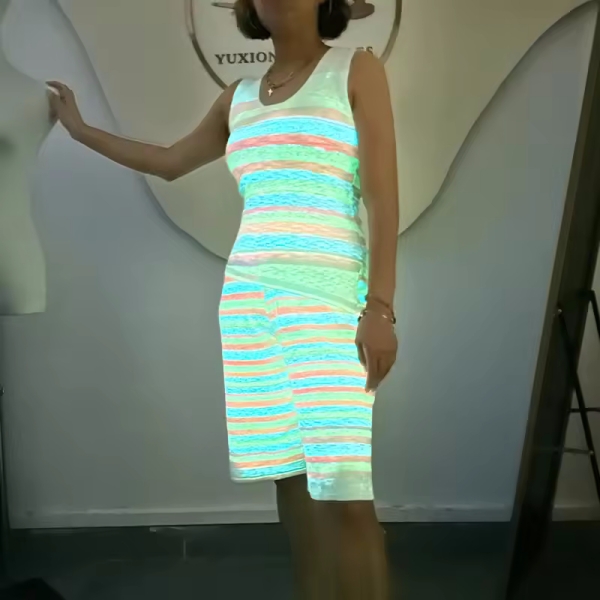1. Color changing clothing was first developed by the US Department of Defense as an invisibility cloak for soldiers, which can change colors according to the surrounding environment. After the 1980s, color changing clothing was widely used in the civilian field.
After entering the 21st century, the development of color changing clothing has made greater progress. For example, Japan has studied a photochromic dye that can dye synthetic fiber fabrics with the colors of surrounding scenery, integrating human clothing into natural scenery; British scientists have processed liquid crystal material microcapsules into printable ink, which is coated on a black fiber surface and rapidly changes with different body parts and body temperature, displaying charming colors; The color changing acrylic thread produced in our country can be woven into fabric and converted into color with the change of light source.
2.Photosensitive color change:
Photosensitive color changing material is a functional dye that can change color under the irradiation of ultraviolet or visible light, and can be reversed back to its original color after the light disappears. Photosensitive color changing materials mainly include silver chloride, silver bromide, styrene, spirocyclic compounds, norbornadienes, succinic anhydrides, triphenylmethane derivatives, salicylic acid aniline compounds, etc. At present, photosensitive color changing materials have developed to four basic colors: purple, yellow, blue, and red. The initial structure of these four photoresist materials is a closed loop type, that is, they are printed on the fabric without color, and only turn purple, yellow, blue, or red when exposed to ultraviolet radiation.
3.Thermally sensitive color change:
The reason why thermosensitive color changing materials can change color is because the color changing body can cause changes in the internal structure, resulting in color changes. When the temperature decreases, the color returns to its original state. Compared to photosensitive dyes, there is much more research on thermosensitive dyes both domestically and internationally, especially in the application of textile printing, which has achieved certain results. A series of thermosensitive printing products have already been launched.
4.Photochromic yarn is a textile with unique characteristics that can display different colors or patterns under different lighting conditions. This type of yarn is made of special fibers and dyes. When it is exposed to ultraviolet or visible light, the dye molecules will change, thereby changing the color or pattern of the yarn.
The advantage of photochromic yarn lies in its reaction sensitivity and durability. When light shines on this type of yarn, the dye molecules will rapidly change, causing the color or pattern of the yarn to immediately change. This rapid reaction ability makes photochromic yarns have broad application prospects in the production of dynamic fashion and smart textiles.
In addition, the durability of photochromic yarns is also very good. After multiple uses and washes, its color or pattern will not fade or disappear. This durability allows photochromic yarns to be used for long-term textile and clothing production without the need for frequent replacement.
Photochromic yarns are widely used in the fashion industry. It can be used to make smart fashion, sportswear, outdoor equipment, household items, etc. For example, you can use photochromic yarn to make a sportswear that emits a faint light in the dark, or use it to make a curtain that can change color under different lighting conditions.
Overall, photochromic yarns are innovative and practical



